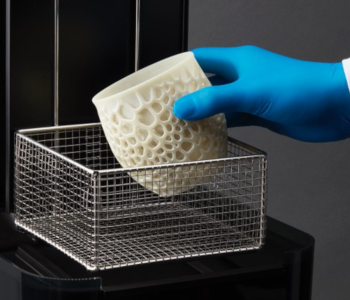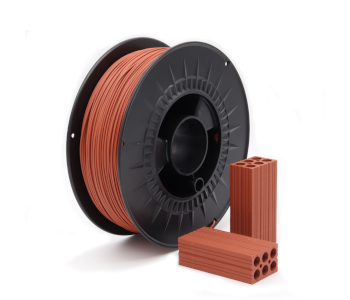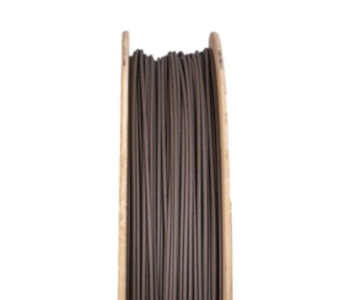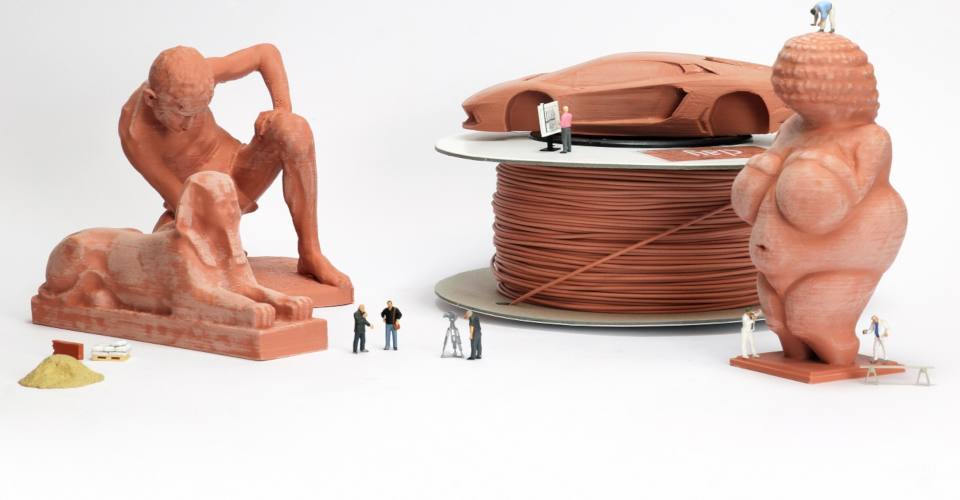3D Printing with Clay Filament
3D printing technology may have made huge strides in the last decade, but most 3D printing processes are still limited to using plastic-based raw materials. While plastic has great workability, it’s not always the best option in terms of visual appeal.
Alternative 3D printing materials are starting to become more popular, one of which is clay filament. Clay is a great choice if you want your 3D printed projects to have a more architectural or decorative appearance. What are the options for 3D printing with clay and are there any clay filaments that are convenient to use?
Options for 3D printing with clay
If you want to 3D print something that will look like clay, there are three options available to you.
Clay filament
The easier method is to use a composite clay filament. Just like other composite filaments, this is made by infusing powdered solid with a plastic matrix, typically PLA. In this case, powdered stone provides both the unique appearance and texture of composite clay filament.
If you have ever printed with composite filament before, then this method should be very easy for you. Composite filaments are fairly simple to work with because they do not have warping issues. You may need to swap out your stock nozzle with something that is more abrasion-resistant. Other than that, printing with composite filament is beginner-friendly.
Clay resin

For those who prefer 3D printing with SLA, FormLabs has developed a special ceramic resin. Described as an affordable way to 3D print highly detailed projects in ceramics, the resin is a combination of photopolymer material with silica. Since photopolymer is stable after curing, the finished 3D print can be baked in a kiln to turn the clay component into real ceramics.
SLA printers are a little more expensive and advanced than FDM printers. This clay resin is also relatively rare compared to composite clay filament – FormLabs may be the only brand that is offering it commercially.
3D printing with real clay
The third option is to print with real clay. This is done by 3D printers that can extrude a clay paste through a computer-controlled nozzle, laying it down layer by layer just like in standard 3D printing. The biggest advantage of this technique is that you can bake the clay in a kiln after 3D printing, effectively making customized ceramic pieces.
However, 3D printing with real clay is very complex. Clay is a soft material. When the clay paste is not prepared properly, the initial layers of the project may be too weak to support the weight of the layers on top of it, causing the print to collapse.
There’s also the fact that a clay 3D printer is not something that you can just buy easily. These are specialized equipment that are used mainly in laboratories and other professional settings. If you’re interested in having a project 3D printed with real clay, you’re better off having your designs printed by someone who offers the technology as a service.
In this article, we’ll be focusing on the option that is most accessible to everyone – composite clay filament. Cheap and easy to use, clay filament is a great place to start for those who want to use 3D printing material that’s a little more special than plastic.
How to print with clay filament
One thing to keep in mind when printing with composite filaments is that different brands probably make their products in different ways. This means that the set of rules for one brand may vary widely from those for another brand. For best results, it is best to consult the manufacturer of your clay filament and ask for best practices.
What we provide here are guidelines that you can play around with as needed. Many of the practices mentioned here apply to most composite filaments.
Use a hardened nozzle
The first thing you need to do before printing with a composite filament is to swap out the stock nozzle of your 3D printer. If it’s made of brass, it would quickly get worn out by the solid particles in the filament. Users who have printed with composite filaments would know this already.
The best replacement is a nozzle made with hardened steel. This material is harder and more resistant to abrasion compared to brass and stainless steel. However, hardened steel has poor thermal conductivity. This means that you will have to give the nozzle more time to reach the target temperature for printing.
Handle the filament with care
Mixing PLA (or any thermoplastic) with powdered stone creates a very brittle filament. If you’re not careful, you could easily end up snapping the filament mid-way. This can cause extrusion problems.
Your best bet would be to make sure that the filament does not go through any sharp turns from the spool to the intake gear. You can also save yourself some headache if your printer has a direct extruder instead of a Bowden extruder.
However, having a Bowden extruder is no longer an impediment to printing with composite filament. If you can nail good extrusion settings, then you should not have a problem.
Clean the nozzle immediately after printing
A piece of advice we don’t often hear is to clean your nozzle right after printing with composite filament. This is good practice when using clay filament as you may end up with residual powdered stone in the inner chamber of the nozzle. Leaving the nozzle uncleaned risks having the residual stone burn. This burnt carbon material is tough and much harder to remove.
The easiest way to clean your nozzle after printing with clay is to simply run around 25 centimeters of standard PLA through the nozzle. The PLA will soak up any of the residual solid powder inside the nozzle.
Use printer settings recommended by the manufacturer
Lastly, make sure to dial in the proper printer settings based on the manufacturer’s recommendations. If you don’t have the benefit of definite numbers, then here is a good place to start:
| Printing temperature | 200 to 240 °C |
| Printing speed | 60 to 70 mm/s |
| Bed temperature | Heated bed not necessary; may set at 60 °C for best results |
| Bed adhesion | Blue painters’ tape or Kapton tape |
| Retraction | Enable at 5 mm retraction distance |
| Cooling | 50% for the first 3 layers; set at maximum for all succeeding layers |
The 3D printing parameters assume that the clay filament uses a PLA base plastic. If another plastic were in the mix, some values (such as the bed temperature) would have to be drastically revised.
Best clay filaments available today
Clay as the basis for a composite filament isn’t quite as popular as metal or wood. This means that there aren’t as many options for clay filaments. Here are the few that we’ve managed to find:
1. FormFutura StoneFil Pottery Clay

The StoneFil clay filament from the FormFutura line is one of the more popular clay filaments. Made with a 50/50 by weight mix of PLA and powdered stone filling, this clay filament has a nice brown color and is more than 30% denser than standard PLA.
With a PLA base, the StoneFil filament is a very beginner-friendly filament. It has a low tendency to warp, which means that you can use it even without a heated bed. Prints made with StoneFil come with a unique matte finish and a characteristic chromatic spectrum gradient. Even if you’re not planning to print lots of projects with clay, the StoneFil filament would be nice to experiment with.
2. TreeD Architectural Clay

The Architectural Clay line of 3D printing filaments from the TreeD brand comes in four different colors – Monumental, Clay, Dark Stone, and Heritage Brick. All of them look great, especially if you’re planning on 3D printing architectural models or miniature versions of famous monuments.
While TreeD has not revealed which type of plastic is blended into their clay filaments, we can tell that it is most definitely not standard PLA. The TreeD clay filament needs a heated bed set at around 100 °C. This is at the high end as far as heated print beds go. The tradeoff is that finished prints can remain rigid until a temperature of about 102 °C.
The TreeD Architectural Clay filament is a more robust and heavy-duty option for clay filaments. This is ideal for professional applications, particularly those in the field of architecture and archeology.
3. Amaco 46D Ceramic Clay Filament

The Amaco Ceramic Clay Filament from The Virtual Foundry is quite unique because its finished product is meant to be fired in a kiln, just like real ceramics. This gives the filament incredible value, especially considering how affordable it is.
According to the manufacturer, this ceramic clay filament is more viscous than standard PLA and is best printed with a nozzle diameter of at least 0.6 mm. It prints at a temperature similar to PLA (205 to 235 °C) but requires a heated bed with a layer of blue painters’ tape.
Should you be interested in firing a print made with this filament, you will need a furnace, a crucible, and refractory material like sand. The finished part needs to be placed inside the crucible and packed with refractory material to prevent it from deforming. It will then have to be exposed to temperatures ranging from 200 to 400 °C for up to five hours.
If you want the full-on ceramic experience, then the Amaco Clay Filament is a great place to start. In terms of 3D printing, the filament is inexpensive, looks great, and is easy to work with. The assumption, of course, is that you have access to a firing kiln.
Final thoughts
Even with the breadth of composite filaments used in 3D printing nowadays, clay is still quite an unconventional choice. However, there is a lot of potential for clay filaments, particularly if you want to make your own miniature copies of architectural structures and monuments.
The unique characteristic of clay is that it can be fired in a kiln to create harder and better-looking ceramics. Some manufacturers of 3D printing filaments and resins have tried to leverage this advantage, making clay materials that can be turned into ceramics. This certainly adds a new dimension to the possibilities of 3D printing. A ceramic miniature figure, made completely via FDM printing, sounds like an interesting project to work on.


